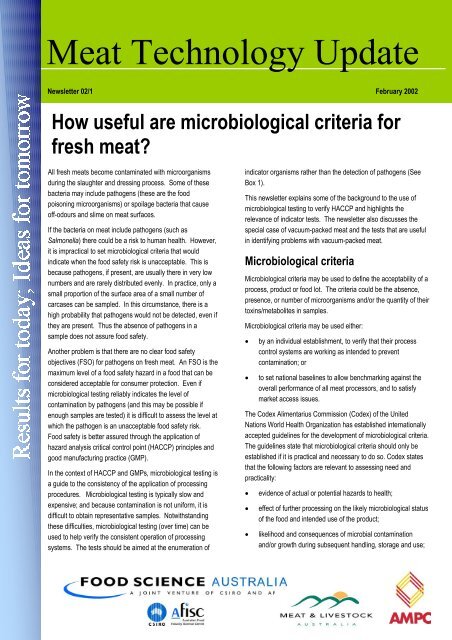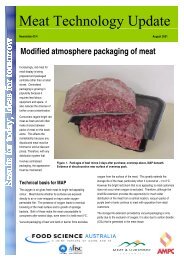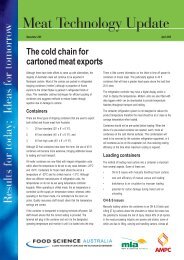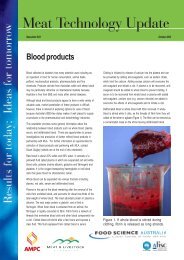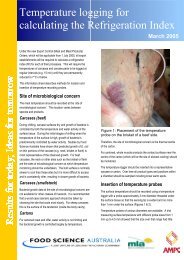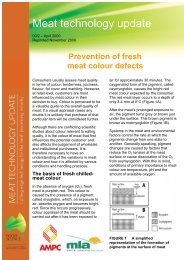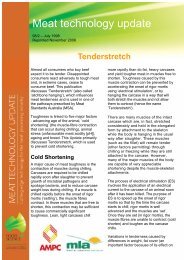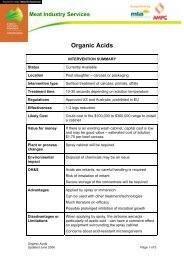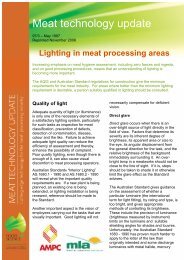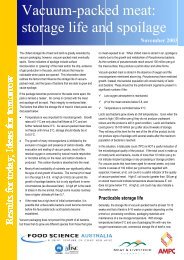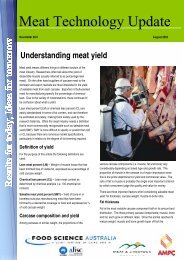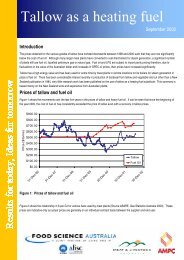How useful are microbiological criteria for fresh meat? - Red Meat ...
How useful are microbiological criteria for fresh meat? - Red Meat ...
How useful are microbiological criteria for fresh meat? - Red Meat ...
You also want an ePaper? Increase the reach of your titles
YUMPU automatically turns print PDFs into web optimized ePapers that Google loves.
<strong>Meat</strong> Technology UpdateNewsletter 02/1 February 2002<strong>How</strong> <strong>useful</strong> <strong>are</strong> <strong>microbiological</strong> <strong>criteria</strong> <strong>for</strong><strong>fresh</strong> <strong>meat</strong>?All <strong>fresh</strong> <strong>meat</strong>s become contaminated with microorganismsduring the slaughter and dressing process. Some of thesebacteria may include pathogens (these <strong>are</strong> the foodpoisoning microorganisms) or spoilage bacteria that causeoff-odours and slime on <strong>meat</strong> surfaces.If the bacteria on <strong>meat</strong> include pathogens (such asSalmonella) there could be a risk to human health. <strong>How</strong>ever,it is impractical to set <strong>microbiological</strong> <strong>criteria</strong> that wouldindicate when the food safety risk is unacceptable. This isbecause pathogens, if present, <strong>are</strong> usually there in very lownumbers and <strong>are</strong> r<strong>are</strong>ly distributed evenly. In practice, only asmall proportion of the surface <strong>are</strong>a of a small number ofcarcases can be sampled. In this circumstance, there is ahigh probability that pathogens would not be detected, even ifthey <strong>are</strong> present. Thus the absence of pathogens in asample does not assure food safety.Another problem is that there <strong>are</strong> no clear food safetyobjectives (FSO) <strong>for</strong> pathogens on <strong>fresh</strong> <strong>meat</strong>. An FSO is themaximum level of a food safety hazard in a food that can beconsidered acceptable <strong>for</strong> consumer protection. Even if<strong>microbiological</strong> testing reliably indicates the level ofcontamination by pathogens (and this may be possible ifenough samples <strong>are</strong> tested) it is difficult to assess the level atwhich the pathogen is an unacceptable food safety risk.Food safety is better assured through the application ofhazard analysis critical control point (HACCP) principles andgood manufacturing practice (GMP).In the context of HACCP and GMPs, <strong>microbiological</strong> testing isa guide to the consistency of the application of processingprocedures. Microbiological testing is typically slow andexpensive; and because contamination is not uni<strong>for</strong>m, it isdifficult to obtain representative samples. Notwithstandingthese difficulties, <strong>microbiological</strong> testing (over time) can beused to help verify the consistent operation of processingsystems. The tests should be aimed at the enumeration ofindicator organisms rather than the detection of pathogens (SeeBox 1).This newsletter explains some of the background to the use of<strong>microbiological</strong> testing to verify HACCP and highlights therelevance of indicator tests. The newsletter also discusses thespecial case of vacuum-packed <strong>meat</strong> and the tests that <strong>are</strong> <strong>useful</strong>in identifying problems with vacuum-packed <strong>meat</strong>.Microbiological <strong>criteria</strong>Microbiological <strong>criteria</strong> may be used to define the acceptability of aprocess, product or food lot. The <strong>criteria</strong> could be the absence,presence, or number of microorganisms and/or the quantity of theirtoxins/metabolites in samples.Microbiological <strong>criteria</strong> may be used either:• by an individual establishment, to verify that their processcontrol systems <strong>are</strong> working as intended to preventcontamination; or• to set national baselines to allow benchmarking against theoverall per<strong>for</strong>mance of all <strong>meat</strong> processors, and to satisfymarket access issues.The Codex Alimentarius Commission (Codex) of the UnitedNations World Health Organization has established internationallyaccepted guidelines <strong>for</strong> the development of <strong>microbiological</strong> <strong>criteria</strong>.The guidelines state that <strong>microbiological</strong> <strong>criteria</strong> should only beestablished if it is practical and necessary to do so. Codex statesthat the following factors <strong>are</strong> relevant to assessing need andpracticality:• evidence of actual or potential hazards to health;• effect of further processing on the likely <strong>microbiological</strong> statusof the food and intended use of the product;• likelihood and consequences of microbial contaminationand/or growth during subsequent handling, storage and use;
• the underlying health of the consumers concerned.Consider these points <strong>for</strong> a case study of Salmonella on red <strong>meat</strong>.For example, there is epidemiological evidence that red <strong>meat</strong> playsa role in foodborne salmonellosis; but the majority of cases <strong>are</strong> <strong>are</strong>sult of poor preparation and cross-contamination after cooking.In addition, an effective cold chain prevents growth of Salmonellaand cooking prior to consumption destroys Salmonella. Using theCodex guidelines, it is not appropriate to test raw <strong>meat</strong> <strong>for</strong>Salmonella <strong>for</strong> the purpose of lot acceptance.The American <strong>Meat</strong> Science Association (AMSA) convened apanel of leading microbiologists, statisticians and other food safetyexperts from USA, Canada, Australia, New Zealand and UnitedKingdom to examine the role of <strong>microbiological</strong> testing in a beeffood safety program. The panel was asked to document thescience behind the sampling process and to present clearrecommendations <strong>for</strong> the evaluation of sampling programs. Thepanel found that:• at no stage during a process will pathogen testing assure foodsafety;• pathogens or other microorganisms at a low incidence cannotbe used to assess process control;• foodborne pathogens will not be detected consistently whenthey <strong>are</strong> not randomly distributed and/or occur at lowincidence;• testing <strong>for</strong> appropriate non-pathogenic organisms will allowvalidation and verification of process control systemsdesigned to improve food safety;• effective <strong>microbiological</strong> testing programs <strong>are</strong> based on soundfood-safety objectives with definable <strong>microbiological</strong>per<strong>for</strong>mance <strong>criteria</strong>;• the main purpose of <strong>microbiological</strong> testing of foods is tovalidate and verify process control measures in the context ofa properly implemented HACCP system.The Australian <strong>meat</strong> industry accepts the recommendations ofgroups such as AMSA and the International Commission onMicrobiological Specifications <strong>for</strong> Foods (ICMSF) and hasimplemented them as part of its <strong>microbiological</strong> testing regimes.Where trading partners require specific testing regimes these havealso been implemented; but, in general, the Australian <strong>meat</strong>industry has successfully implemented HACCP programs as thepreferred food safety management strategy.Indicator tests <strong>for</strong> <strong>meat</strong><strong>Meat</strong> can be contaminated with a variety of pathogens and spoilagebacteria and it would be difficult to monitor each of these organismsin a meaningful way. Indicator organisms <strong>are</strong> groups of bacteriathat indicate the possible presence of organisms of concern, andmay point to the origins of microbial contamination. Generally, itcan be assumed that the numbers of a pathogen <strong>are</strong> less than thenumbers of the corresponding indicator organism. Also, <strong>are</strong>duction in the number of indicator organism will produce a similarreduction in the number of any pathogen associated with it.Total Viable CountsMost of the bacteria on <strong>fresh</strong>ly dressed carcasses will be from thehides or skins of the animals. Some of the contamination will be offaecal origin but it will include the normal flora of the skin(staphylococci, micrococci, pseudomonads, yeasts and moulds) aswell as a variety of organisms from soil and water. Only a smallproportion of bacteria present <strong>are</strong> able to grow once the <strong>meat</strong> hasbeen chilled and factors such as temperature, surface dryness andgaseous atmosphere, will influence how quickly these bacteria canmultiply.In the presence of oxygen and under moist conditions (as <strong>for</strong> <strong>meat</strong>prepackaged on trays) the bacterial population will increase quicklyand will probably be dominated by pseudomonads. Off odours andslime on the <strong>meat</strong> surface <strong>are</strong> evident when pseudomonads reach100-500 million per cm 2 . Imminent spoilage of the <strong>meat</strong> could beanticipated if a total bacterial count approaches these numbers.<strong>How</strong>ever, in vacuum-packed <strong>meat</strong>, the packaging brings aboutchanges in the bacterial flora, and the storage life depends more onthe nature of the flora that develops during storage than on the totalnumbers of bacteria present after processing.Generic E. coliMost E. coli <strong>are</strong> derived, directly or indirectly, from the rumen or thelower intestinal tract contents. For this reason, E. coli is consideredto be a specific indicator of potential faecal contamination during theslaughter and dressing process.The growth and survival characteristics of E. coli <strong>are</strong> broadlycomparable to many pathogenic Enterobacteriaceae species such asSalmonella and pathogenic E. coli. There<strong>for</strong>e, increases in E. coliduring chilling, storage and distribution suggest that the <strong>meat</strong> hasbeen subjected to conditions, which would also allow growth of thesepathogens.Coli<strong>for</strong>msColi<strong>for</strong>ms <strong>are</strong> part of the Enterobacteriaceae family of bacteria andinclude E. coli, Enterobacter, Klebsiella and Citrobacter. A majordrawback to the use of coli<strong>for</strong>ms as indicators of pathogencontamination in chilled <strong>meat</strong> is that many of them <strong>are</strong> capable ofgrowth below 5°C. E. coli cannot grow below 7°C, so a high coli<strong>for</strong>mcount does not necessarily indicate growth of faecal pathogens.Elevated numbers of coli<strong>for</strong>ms <strong>are</strong> evidence that processing orunsatisfactory post-process contamination might have occurred, butthe history of the product must be examined closely be<strong>for</strong>e theprecise nature of the problem can be determined.
Hazard analysis and control systemsWithin the HACCP framework the Australian standards <strong>for</strong> hygienic<strong>meat</strong> production require bacterial testing <strong>for</strong> validation of processesand verification of process control. The primary application oftesting is to support process control. Total viable counts and E. coli(Biotype 1) <strong>are</strong> used to verify slaughter floor processes, <strong>for</strong>evaluating the effectiveness of cleaning procedures and to monitorchilling practices. Adverse trends in bacterial numbers or detectionrates can be identified and actions taken to correct elements of theproduction system.The Australian industry collects and analyses carcase samples <strong>for</strong>verification of process control systems, and to satisfy marketaccess issues. In the export sector, ESAM (carcase<strong>microbiological</strong> monitoring program <strong>for</strong> E. coli and Salmonella)<strong>microbiological</strong> data <strong>are</strong> collated by AQIS and used to set nationalbaselines.Baselines set a range in which <strong>microbiological</strong> test results <strong>are</strong>expected to fall. If results fall outside the range, there is a highprobability that the result is from a different population distributionthan the baseline data set. This is interpreted to mean that thesample is from <strong>meat</strong> that has not been processed according to theusual hygiene procedures and an investigation of procedures istriggered.Data obtained in national surveys include test results from <strong>meat</strong>produced in a wide range of processes. National baseline dataallow benchmarking against the overall per<strong>for</strong>mance. For aparticular establishment, it is even more <strong>useful</strong> to look at the rangeof results from a specific process, and use this range to set abaseline from which per<strong>for</strong>mance of the process can be judged.Baselines can also be used to set sampling plans intended to beused <strong>for</strong> accepting of rejecting lots. For example, a food safetyobjective could be a determination that the presence of Salmonellain a lot is an unacceptable food safety risk. The distribution of theincidence of Salmonella in baseline data can be used to design asampling plan that has a known probability of identifying lots that donot comply with the food safety objective.The prevalence of Salmonella on carcases has been reported as0.31% <strong>for</strong> beef and 0.63% <strong>for</strong> sheep. To have a 90% probability ofdetecting Salmonella on beef carcases if the average incidence is0.31% it is necessary to test 1171 samples. In practice it is notpossible to design a commercially acceptable sampling plan todetect contaminated lots when the incidence of contamination is atsuch a low level.ConclusionsDespite the opinions of independent, scientific expert groups suchas ICMSF and AMSA, results of sampling plans <strong>are</strong> still used tojudge the quality of the particular product (lot) under evaluation.This is done despite the overwhelming probability that the wrongdecision will be made i.e. rejection of a con<strong>for</strong>ming lot andacceptance of a noncon<strong>for</strong>ming lot, depending on the test procedureand specification.The most effective way of controlling quality is through monitoringand appropriate intervention during the production process to assurethat food safety standards <strong>are</strong> continuously met. On its own, testingdoes not provide enough in<strong>for</strong>mation to assure food safety. A farbetter approach is the adoption of HACCP and the validation ofcontinuing per<strong>for</strong>mance through targeted sampling programs.Routine testing of raw <strong>meat</strong> <strong>for</strong> the presence of pathogenic bacteriasuch as Salmonella <strong>for</strong> the purpose of lot acceptance cannot bescientifically justified.Further ReadingVanderlinde, P., Shay, B., Murray, J. (1998) Microbiological quality ofAustralian beef carcass <strong>meat</strong> and frozen bulk packed beef. Journal ofFood Protection. 61: 437-443.Vanderlinde, P., Shay, B., Murray, J. (1999) Microbiological status ofAustralian of sheep <strong>meat</strong>. Journal of Food Protection. 62: 380-385.Phillips, D. et al. (2001) Microbiological quality of Australian beef.Journal of Food Protection. 64: 692-696.Phillips, D. et al. (2001) Microbiological quality of Australian sheep<strong>meat</strong>. Journal of Food Protection. 64: 697-700.Key points <strong>for</strong> IndustryWhen using bacterial test results to assess <strong>fresh</strong> <strong>meat</strong>, processorsshould:• concentrate on problem prevention and process improvementby testing to detect trends and monitor process control;• use them to validate activities that <strong>are</strong> the key to the successfulapplication of HACCP;• recognise that quantitative indicators provide a much moreeffective tool <strong>for</strong> verifying that HACCP is properly implemented;• recognise that the choice of target organisms should be processand product specific;• realise that the methods chosen should be based on scienceand the resources available in an industrial setting
Relevance of microbial <strong>criteria</strong> applied tovacuum-packed <strong>meat</strong>The <strong>Meat</strong> Standards Committee of ARMCANZ (Agriculture andResource Management Council of Australia and New Zealand)introduced the guidelines ‘Microbiological testing <strong>for</strong> processmonitoring in the <strong>meat</strong> industry’. These guidelines expand on therequirements of the Australian standards to do <strong>microbiological</strong>testing at <strong>meat</strong> processing plants. The guidelines give examples ofhow to interpret <strong>microbiological</strong> counts and <strong>are</strong> appropriate <strong>for</strong> red<strong>meat</strong> in carcases and pieces, but they <strong>are</strong> not appropriate <strong>for</strong>vacuum-packed primals.Vacuum packaging does not prevent the growth of all bacteria, butthose that do grow <strong>are</strong> quite different species from those that growon <strong>meat</strong> exposed to air. When <strong>meat</strong> is stored in air, underrefrigeration, spoilage is mainly due to the growth and metabolismof Pseudomonas bacteria. As the numbers of pseudomonadsreach around 100 million per cm 2 they produce a putrid odour andslime <strong>for</strong>ms on the <strong>meat</strong> surface.Vacuum-packed <strong>meat</strong> is stored in the absence of oxygen and thestrict aerobes mentioned above cannot grow and metabolise.Instead, the bacterial population will consist mainly of lactic acidbacteria. These will be the only organisms present in significantnumbers if the low oxygen atmosphere is maintained, the pH of the<strong>meat</strong> remains below 5.8 and the temperature is controlled below4 o C.Lactic acid bacteria grow slowly at chill temperatures and even whenthe count is high (100 million per g) they do not produce unpleasantodours and the product is still in good condition. In contrast,pseudomonads at a similar concentration would start to show signsof off-odour, but because of the absence of oxygen, the growth ofthis group of bacteria is suspended.In this situation, a total viable count is not a <strong>useful</strong> indication of the<strong>microbiological</strong> quality of the product. If the total count is made up oflactic acid bacteria, counts of more than 10 million per g do notindicate incipient spoilage or any processing or storage problem.<strong>How</strong>ever, an E. coli count is a <strong>useful</strong> indicator of the quality ofvacuum-packed <strong>meat</strong> and is similar to the assessment of a carcase,that is, the E. coli count should be low. E. coli counts on stored<strong>meat</strong> could indicate temperature abuse because E. coli do not growbelow 7 o C.If vacuum-packed <strong>meat</strong> has a pH greater than 6.0, spoilage bacteriasuch as Brochothrix thermosphacta, Shewanella putrefaciens, andpsychrotrophic enterobacteria may play a role in spoilage. In high pH<strong>meat</strong>, the glucose content is lower, and off odours may be detectedwhen the bacterial count is just over 1 million per cm 2 . Thesebacteria will cause souring, and in the case of Shewanellaputrefaciens, spoilage is indicated by a greening of the <strong>meat</strong> surfaceand a strong hydrogen sulphide odour (like rotten eggs).The in<strong>for</strong>mation contained herein is an outline only and should not be relied on in place of professional advice on any specific matter.Food Science Australia <strong>Meat</strong> Industry Services SectionThe <strong>Meat</strong> Industry Services (MIS) Section of Food Science Australia is an initiative supported by <strong>Meat</strong> and Livestock Australia (MLA) and theAustralian <strong>Meat</strong> Processor Corporation (AMPC) to facilitate market access <strong>for</strong>, and support world-class practices in, Australia ’s <strong>meat</strong> industry.Need additional in<strong>for</strong>mation help, in<strong>for</strong>mation or advice?Contact any of the following:For more in<strong>for</strong>mation, contact one of the <strong>Meat</strong> Industry Services staff listed below.Ian Eustace Bill Spooncer Neil McPhail Jocelyn Midgley Chris SentanceFood Science Australia Food Science Australia Food Science Australia Food Science Australia PO Box 178PO Box 3312 PO Box 181 PO Box 3312 PO Box 3312 FLAGSTAFF HILLTINGALPA DC QLD 4173 KURMOND NSW 2757 TINGALPA DC QLD 4173 TINGALPA DC QLD 4173 SA 5159Telephone 07 3214 2117 Telephone 02 4567 7952 Telephone 07 3214 2119 Telephone 07 3214 2109 Telephone 08 8370 7466Facsimile 07 3214 2103 Facsimile 02 4567 8952 Facsimile 07 3214 2103 Facsimile 07 3214 2103 Facsimile 08 8370 7566Mobile 0414 336 724 Mobile 0414 648 387 Mobile 0414 336 907 Mobile 0414 647 231 Mobile 0419 944 022Past copies of this newsletter can be obtained from: www.<strong>meat</strong>update.csiro.au4


